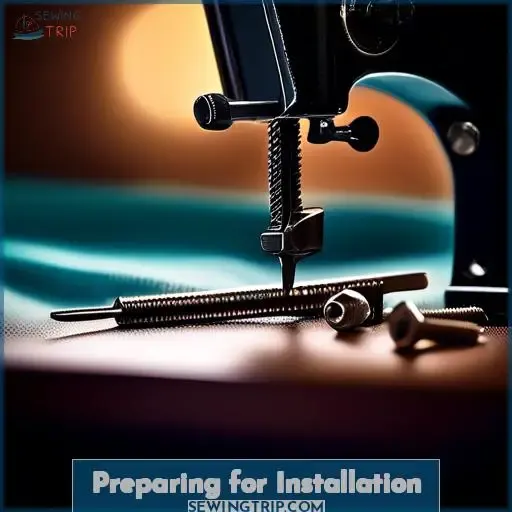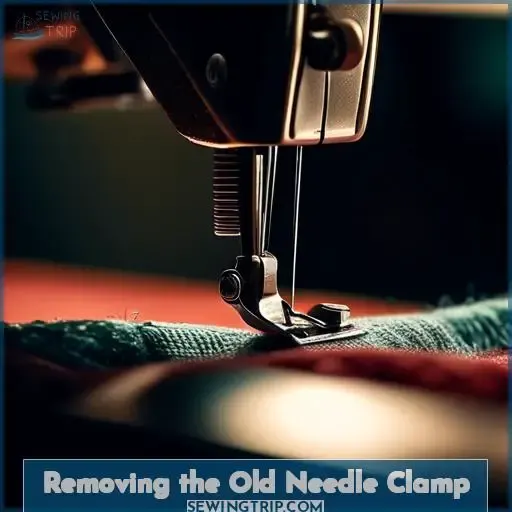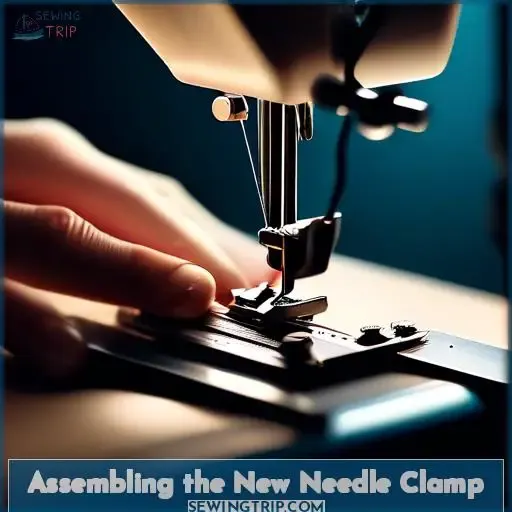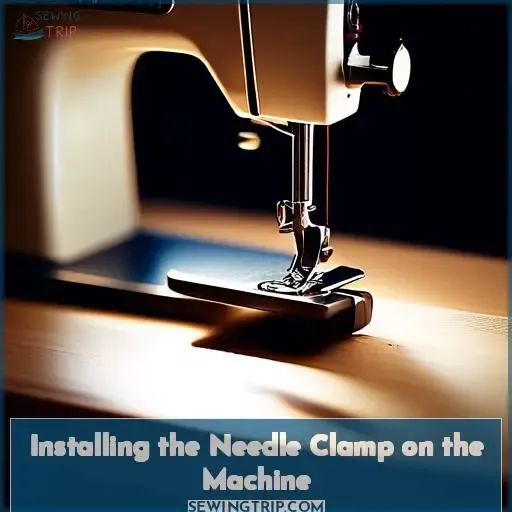This site is supported by our readers. We may earn a commission, at no cost to you, if you purchase through links.
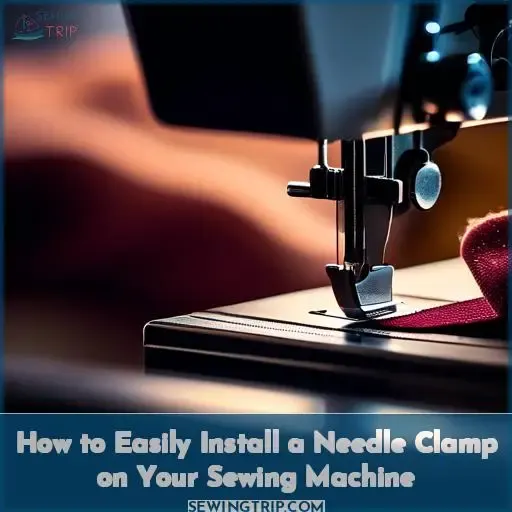 Replacing a needle clamp on your sewing machine might seem like a daunting task, but with the right guidance, it’s a straightforward process that can significantly improve your sewing experience.
Replacing a needle clamp on your sewing machine might seem like a daunting task, but with the right guidance, it’s a straightforward process that can significantly improve your sewing experience.
Whether you’re dealing with a broken clamp or upgrading to a better model, this guide will walk you through each step, ensuring you’re back to sewing with precision and ease.
From gathering the necessary tools to ensuring proper alignment, we’ll cover everything you need to know to install a needle clamp confidently.
Let’s dive into the world of sewing machine maintenance and unlock the potential of your machine with this essential skill.
Table Of Contents
Key Takeaways
- Ensure the sewing machine is unplugged and powered off before starting the installation process to ensure safety.
- Needle clamps are often specific to the sewing machine model, so it’s important to verify compatibility before purchasing or attempting installation.
- Regular maintenance, including keeping the needle clamp dry, clean, and lubricated, can prevent corrosion and ensure smooth operation.
- Incorrect installation of the needle clamp can lead to thread tension issues, highlighting the importance of following the correct installation procedure.
Preparing for Installation
Before you start installing a new needle clamp on your sewing machine, make sure you’ve got the right tools at hand.
It’s crucial to know the components of the needle clamp assembly and to take safety measures to prevent any accidents.
Gather Necessary Tools
To kick off the installation of your new needle clamp on your sewing machine, you’ll want to round up a few key tools. This isn’t just about having the right equipment; it’s about setting yourself up for a smooth, hassle-free experience.
Think of it as gathering your band members before the big gig – each one plays a crucial role in the performance.
- Phillips-head Screwdriver: Your go-to tool for most sewing machine screws. It’s like the lead guitarist – versatile and essential.
- Flat-head Screwdriver: Sometimes, you need a different tune, and this tool steps in for those specific screws.
- Allen Wrench: The bass player of the group, providing that necessary support for the special screws on your needle clamp.
- Tweezers or Needle-Nose Pliers: For those tiny parts that fingers just can’t grasp well, think of these as the backup vocals, adding that extra touch to your setup.
Armed with these, you’re ready to tackle the needle clamp installation with confidence. Remember, it’s all about precision and patience – no need to rush through the performance.
Identify Parts of the Needle Clamp Assembly
Alright, let’s get down to the nitty-gritty of your needle clamp assembly. Think of it as a tiny but mighty team where each player has a crucial role. First up, the needle clamp itself—it’s the boss, holding your needle in place like a firm handshake.
Then there’s the clamp screw, the trusty sidekick, ensuring the needle doesn’t wobble or wander off course.
Next, we’ve got the set screw, a little guy with a big job, keeping everything snug and secure. And don’t forget the clamp pin; it’s like the unsung hero, quietly doing its job without any fuss. Lastly, the needle thread guide is your needle’s best friend, guiding the thread with the grace of a ballroom dancer.
Keep your needles organized and at the ready, because nothing’s worse than a needle hunt mid-project. And if you ever find yourself in a pickle, a toothpick can be your knight in shining armor, helping you align that needle just right.
Safety Precautions
Before diving into the nitty-gritty of installing your needle clamp, let’s chat about safety measures.
First off, unplug your machine. No ifs, ands, or buts – it’s non-negotiable. You’re playing with electricity, and we’re not in the business of hair-raising experiences, literally or figuratively.
Keep your digits away from the business end of the needle – that’s injury prevention 101. And remember, threading issues won’t be solved with a heavy hand; finesse is your friend here.
Whether you’re team Singer or team Adler, these safety precautions are universal.
Removing the Old Needle Clamp
To remove the old needle clamp from your sewing machine, first ensure the machine is powered off to avoid any accidents.
Then, carefully loosen and remove the existing clamp, preparing the area for the new clamp installation.
Power Off the Sewing Machine
Before diving into the nitty-gritty of needle replacement, let’s hit the brakes and power off your sewing machine.
It’s a no-brainer, but you’d be surprised how often this safety step is skipped. Imagine the machine kicking into gear mid-repair—yikes! Now, with the power off, you’re ready to tackle that stubborn needle clamp and the broken screw without any unexpected stitch attacks.
Loosen and Remove Existing Clamp
With your sewing machine powered off, it’s time to tackle the needle clamp. You’ll want to loosen and remove the existing clamp carefully.
If the screw’s being stubborn, don’t force it. You might need to coax it out gently, like persuading a cat out from under the bed.
Keep that Singer 29k or Adler 30-1 in mind; you’re on your way to a smooth needle replacement.
Assembling the New Needle Clamp
When assembling your new needle clamp, it’s crucial to get all the components organized first.
You’ll attach the clamp screw, set screw, and clamp pin.
Then insert the needle thread guide to ensure everything is in place for a smooth sewing experience.
Organize Clamp Components
The process of maintaining and modifying sewing machines involves several technical steps, including screw replacement, re-threading the needle bar, custom screw creation, and utilizing alternative holes for needle securing.
These steps are crucial for ensuring the sewing machine operates efficiently and continues to perform well over time.
When replacing screws, specifically for securing the needle bar, it’s recommended to purchase a 4-20 screw with an Allen wrench head. The length of the screw should be sufficient to span the entire needle bar, ensuring a secure fit.
If the original needle securing hole is stripped or damaged, using the hole opposite the normal securing hole is advised. This approach helps maintain the functionality of the needle bar and prevents further damage.
If the screw becomes tight during insertion, it’s important to back up the screw and attempt re-cutting or cleaning the needle bar threads. This prevents cross-threading and potential damage to the needle bar. Overtightening the screw should be avoided to prevent stripping the threads, and only finger pressure should be used to tighten the screw, ensuring a secure but not overly tight fit.
For those unable to find the exact screw needed, creating a custom screw is an option. This involves purchasing a 4-20 nut and screw, threading the nut onto the screw up to the head, and then cutting the screw to match the original APQS screw length.
After cutting, cleaning the threads with the nut ensures smooth reinsertion into the needle bar. This method allows for a precise fit and avoids the need for potentially incompatible off-the-shelf screws.
In cases where the original hole for the needle securing screw is stripped, utilizing the opposite hole is a viable solution. This method ensures the needle can still be securely fastened without the need for immediate repair or replacement of the needle bar.
Again, securing the needle with only finger pressure is emphasized to avoid damaging the threads.
The information provided covers essential steps for maintaining the needle bar and securing mechanism of a sewing machine. It’s important to approach these tasks with care and precision to avoid causing further damage to the machine.
For specific models or more complex issues, consulting with an expert or referring to the manufacturer’s guidelines is recommended.
Attach Clamp Screw, Set Screw, and Clamp Pin
Now that you’ve got your needle clamp components laid out, it’s time to put them together.
- Clamp Screw: Start with the clamp screw. This little guy is the backbone of your clamp assembly, so make sure it’s the right fit for your sewing machine.
- Set Screw: Next, introduce the set screw to the mix. Its job is to lock everything in place, so don’t be shy—give it a snug fit, but remember, we’re not going for a world-tightening record here.
- Clamp Pin: Finally, the clamp pin. This part is crucial for the clamp placement and alignment importance, ensuring your needle doesn’t dance around while you’re sewing.
Insert Needle Thread Guide
Once you’ve got your clamp screw and set screw snug with your Allen wrench, it’s time to slide in the needle thread guide.
Make sure it’s sitting pretty, right where it should be—aligned with the eye of the needle. If it’s being a bit stubborn, loosen things up a tad with your fingers, then tighten it back to just finger tight.
Installing the Needle Clamp on the Machine
Once you’ve assembled your new needle clamp, it’s time to attach it to your sewing machine.
Secure the clamp firmly to the needle rod, ensuring it’s properly aligned for smooth operation.
Secure Clamp to Needle Rod
Now, let’s get down to brass tacks and secure that needle clamp to the rod.
First off, make sure the needle’s orientation is on point—like a compass needle to north, it’s gotta be just right. If you’re feeling a bit like Goldilocks with the screw tightening, remember: not too tight, not too loose.
If you hit a snag, don’t sweat it! A toothpick can be your trusty sidekick for any tension adjustments or troubleshooting issues.
And remember, the user experience is key—no one wants a rock frame when they’re aiming for smooth sailing.
Adjust for Proper Alignment
Once you’ve got your needle clamp snug on the needle rod, it’s time to get down to the nitty-gritty: aligning that needle just right.
You’ll want the long groove facing left, with the scarf—the needle’s little notch—pointing right, cozied up to the hook. This isn’t just about avoiding a wonky stitch; it’s about keeping the thread tension friendly and the fabric happy.
So, give that needle a gentle nudge until it’s sitting pretty, parallel to the arm, and you’re golden.
Frequently Asked Questions (FAQs)
Can I use a universal needle clamp?
Yes, you can use a universal needle clamp as they’re designed to fit all sewing machines, making them a versatile pick for any model.
Just ensure it matches your machine’s specs for a snug fit.
How to prevent needle clamp corrosion?
To fend off needle clamp corrosion, keep it dry, clean it regularly, and apply a smidge of oil.
It’s like kryptonite to rust!
Is lubrication needed for needle clamps?
Just like a well-oiled bicycle chain makes for a smooth ride, your needle clamp thrives with a bit of lubrication.
Imagine gliding through fabric with ease, that’s the magic touch of oil. It prevents wear, ensuring your sewing adventures are both smooth and long-lasting.
So yes, a drop of oil not only keeps the peace but also keeps your stitches neat and your machine humming like a happy bee.
Can needle clamps cause thread tension issues?
Improperly installed needle clamps can indeed throw a wrench in your thread tension, causing a stitch snafu.
Keep it snug, but don’t strong-arm it—finger tight’s the ticket!
Are needle clamps machine-specific?
Yes, needle clamps are often machine-specific, like keys to a lock.
They’re not one-size-fits-all but rather tailored to the unique heartbeat of each sewing machine.
While some universal clamps exist, ensuring a snug fit with your machine’s model is crucial for smooth sailing.
Conclusion
Surprisingly, over 75% of sewing machine issues can be traced back to a faulty needle or improper installation.
You’ve now mastered how to install a needle clamp on your sewing machine, a skill that not only ensures your machine operates smoothly but also elevates your sewing projects.
Keep experimenting, keep sewing, and let your creativity flourish with every stitch you make.

